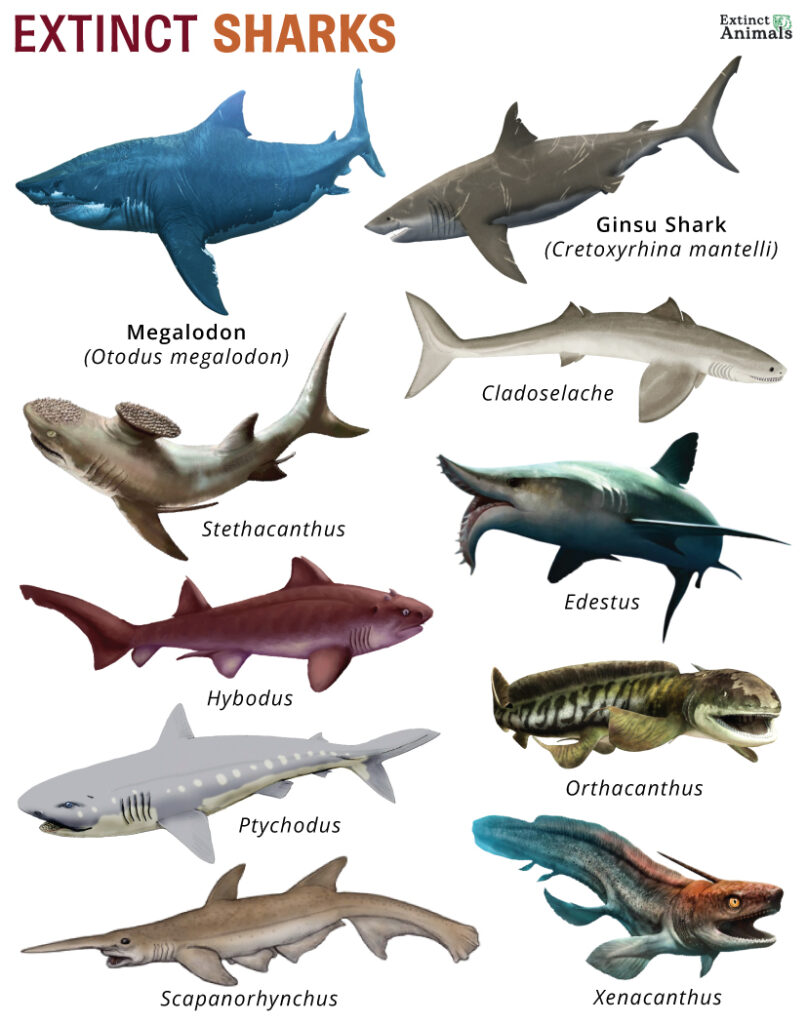Sharks are some of the most ancient creatures, predating dinosaurs, insects, and even some flora. They have survived multiple extinction-level events, including the Cretaceous-Paleogene Event that is believed to have killed the dinosaurs, and have changed very little over time, indicating that these marine animals are extremely adaptable.
However, some sharks could not adapt to the world around them and died out. Which species of sharks died out, when did they thrive, and most importantly, why did they go extinct?

| Name | Characteristics | Where Did It Live | When Was It Active | Reason for Extinction |
|---|---|---|---|---|
| Megalodon (Otodus megalodon) | 1. Hunted large prey like whales and sea turtles 2. Possessed strong jaws and teeth capable of bursting through the chest cavity of its prey, puncturing their heart and lungs 3. Large size usually the result of bigger fetuses eating the smaller ones in utero | Worldwide | Early Miocene (23.03 million years ago) to the Late Pliocene (2.58 million years ago) | As these sharks lived in tropical waters, with a drop in global temperature in the ocean due to the planet cooling, their habitats became restricted. |
| Ginsu Shark (Cretoxyrhina mantelli) | 1. Apex predator that even fed on plesiosaurs, mosasaurs, and even dinosaurs 2. Capable of swimming at speeds of up to 43 mph | Europe and North America | Late Albanian (100 million years ago) to Late Campanian (83 to 72 million years ago) | Increased competition from other predators, most notably the mosasaur Tylosaurus. |
| Cladoselache | 1. Streamlined body similar to the Great White and Mako sharks | North America | Late Devonian (382.7 to 372.2 million years ago) | Likely due to competition from other piscivores over limited resources. |
| Stethacanthus | 1. Unique anvil-shaped fins on their backs | Asia, Australia, Europe, and North America | Late Devonian (382.7 to 372.2 million years ago) to Late Carboniferous (323.2 to 298.9 million years) | Probably due to being preyed upon by prehistoric fish like Dunkleosteus. |
| Orthacanthus | 1. Freshwater shark 2. Primarily fed on Triodus fish 3. Records of cannibalism exist | Europe and North America | Upper Carboniferous (358 million years ago) to the Lower Permian (251 million years ago) | Change in the environment and competition from other freshwater sharks. |
| Xenacanthus | 1. Freshwater shark | Europe and the Americas | Devonian (360 million years ago) to Triassic (208 million years ago) | Changes in its environment |
| Hybodus | 1. Oppurtunistic predator 2. Capable of hunting down swift swimming prey | Worldwide | Late Devonian (382.7 to 372.2 million years ago) to Late Cretaceous (100.5 to 66 million years ago) | Competition with other sharks, most notably mackerel sharks. |
| Ptychodus | 1. Strong teeth capable of crushing the shells of bivalves and ammonites. | Mexico | Late Cretaceous (100.5 to 66 million years ago) | These sharks had small litters whose pups would mature late in life, making them highly susceptible to environmental changes. |
| Edestus | 1. ‘Scissor-like’ teeth 2. Probably the largest marine predator of its time | Russia, the UK, and the US | Late Carboniferous (298.9 million years ago) | Probably due to the lack of shallow water for breeding pools. |
| Scapanorhynchus | 1. Similar in appearance to the Goblin Shark | North America | Early Cretaceous (145 million years ago) to Miocene (23 to 5 million years ago) | Unclear, may be due to limited range. |
| Anisopleurodontis pricei | 1. Similar in physiology to ratfish and chimeras | Brazil | Permian (298 to 252 million years ago) | Maybe due to competition with other predators. |
Some species, like the Goblin, Frilled, and Pondicherry Sharks, were thought to have become extinct but were discovered to be still alive. The Goblin and Frilled Sharks rarely venture into areas where human activity occurs. Meanwhile, sightings of the critically endangered Pondicherry Shark have taken place as recently as 2016.